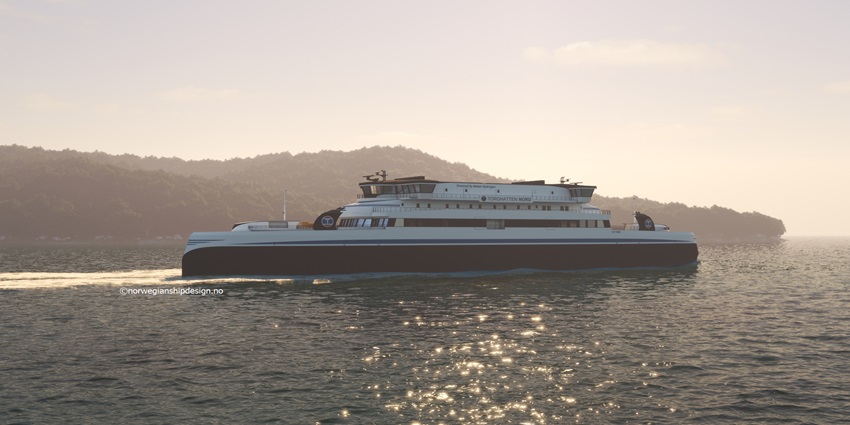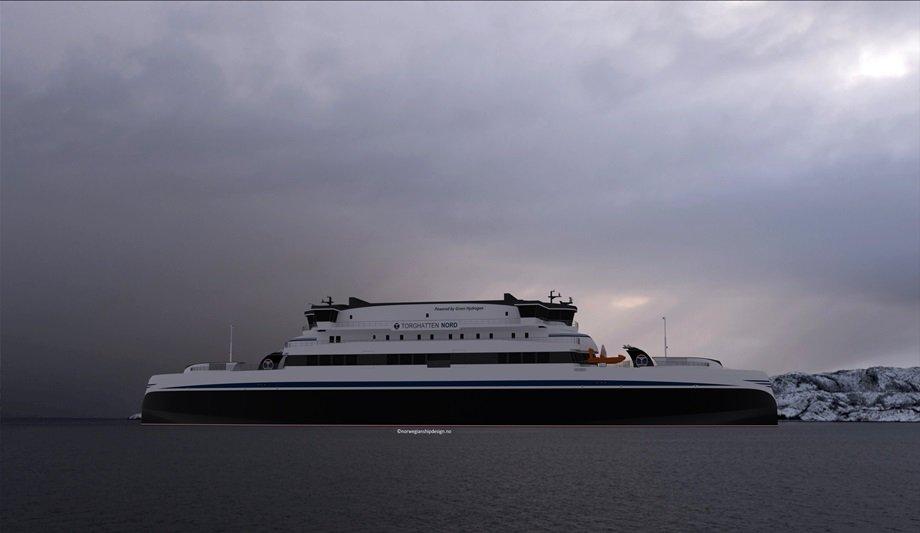Brunvoll has been contracted to deliver the propulsion, manoeuvring, and autonomy systems for two hydrogen-powered ferries for Torghatten Nord AS.
Innovative ship design
The ferries will operate the harsh route to and from Lofoten in Norway, more specifically the Bodø-Verøy-Røst-Moskenes route.
The ferries are of a new and innovative ship design with hydrogen fuel cells in mind, and the designer is The Norwegian Ship Design Company AS. Both ferries included in the contract will be delivered from Myklebust Yard in 2026.

Azimuth propulsion thrusters
The pulling azimuth propulsion thrusters are of the largest size that Brunvoll delivers currently
The Brunvoll contract includes two azimuth propulsion thrusters, BruCon Propulsion & ThrusterControl System, BruCon Auto-Crossing System, and BruCon Condition Monitoring System.
The pulling azimuth propulsion thrusters are of the largest size that Brunvoll delivers currently. The illustration in this article shows the sheer size of the propulsion units.
Propulsion, manoeuvring, and autonomy solutions
The installation of high propulsion power is one of the design considerations that make the vessels ready for the rough sea conditions experienced in this area which is open towards the North Sea.
"We see Brunvoll as a good and reliable collaboration partner for propulsion, manoeuvring, and autonomy solutions. When approaching such a game-changing project we want to source the best solutions from able suppliers,“ says Leiv Sindre Muren, CEO at Myklebust Yard.
BruCon Condition Monitoring System
The contract for these routes came with a specified requirement for hydrogen-powered vessels
The BruCon Condition Monitoring System will allow for remote monitoring and operational optimisation throughout the vessel's lifetime. Replacing the older ferries with hydrogen-powered new builds will lead to an estimated CO2 emission saving of 26.500 metric tons.
The routes are part of Norway's national road network, and the Norwegian Public Roads Administration has set clear goals for emissions reduction for all new public ferry tenders. The contract for these routes came with a specified requirement for hydrogen-powered vessels, and the Norwegian maritime industry has stepped up for the challenge.
Hydrogen-powered vessels
To simplify the vessel's day-to-day operation the BruCon Auto-Crossing system will be installed to ensure energy-efficient
The hydrogen-powered vessels will be a new experience for all vessel owners, vessel operators, and vessel crew.
To simplify the vessel's day-to-day operation the BruCon Auto-Crossing system will be installed to ensure energy-efficient crossing of the Ytre Vestfjord (the Outer Western Fjord) on each transit, irrespective of onboard crew, weather conditions, and other disturbances the bridge crew will have to manage.
Delivery and commissioning
“We are excited to take part in Myklebust Yard and Torghatten Nord’s journeys towards hydrogen-powered vessels,” says KåreØyvind Vassdal, CEO at Brunvoll.
"The harsh weather conditions outside Lofoten will allow us to demonstrate the robustness of our BruCon Auto-Crossing autonomy system for ferries and we are looking forward to the delivery and commissioning for Myklebust Yard."
